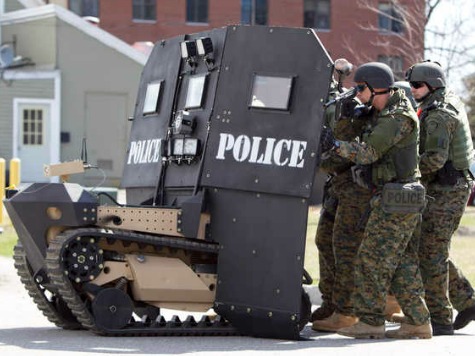
Pedro Vargas set fire to his South Florida apartment last Saturday, killed six innocent people, including a seventeen year old girl, and held two others hostage at gunpoint for three hours before a Hialeah SWAT team stormed the complex, broke into the barricaded apartment, and fatally shot Vargas.
Overkill? Hardly.”Our procedure is that we don’t wait, we enter and engage,” a Hialeah police spokesman told a reporter. “We believe that it was our pursuing him that made him run for cover and barricade himself in that apartment, and kept him from killing more people.”
Libertarian journalist Radley Balko has been making hay over the supposed militarization of the police. In a raft of television interviews, op-eds, and other appearances promoting his new book on the subject he laments the Rise of the Warrior Cop, listing a series of SWAT team raids gone wrong. Some of Balko’s examples are certainly indefensible examples of untrained officers or unprofessional police conduct, sometimes resulting in horrible and tragic results.
Certainly, the police should be the first to safeguard citizens’ constitutional protections under the Bill of Rights, but the few bad examples Balko uses to make his case are vastly outnumbered by successful SWAT operations that save innocent lives and prevent further crimes.
Police work is dangerous. In 2012 alone, 120 U.S. law enforcement officers were killed in the line of duty, and thousands more were threatened and wounded. Violent, heavily armed felons, sometimes high on PCP or other drugs, confront police somewhere in the country on a daily basis. Oftentimes a highly-trained and professional SWAT team is the only way to neutralize the criminal, saving innocent lives and protecting the safety of law enforcement officers in the process.
Balko is critical of the trend toward the “militarization” of local police. He is right that police are more heavily armed than they once were, that many departments use flak jackets, gas masks, and other protective military-type equipment. They are often armed with military weapons, armored personnel carriers, and even small tanks.
Most such equipment is military surplus, usually compliments of the US government. Is it necessary? Few people objected to the use of such materiel in the Boston Marathon bombing case, even in liberal Massachusetts, and are unlikely to object when their own safety and lives are at stake. And after listening to Balko, one would think that police are outfitted like the Delta Force all of the time–which is hardly the case.
SWAT teams do serve a legitimate purpose but, like anything else, can be misused.Good training is essential, as are guidelines that are specific as to when they should and should not be used. Perhaps most important is a highly trained and professional team leader who spends hour after hour training his men and who has the professional judgment that only comes with vast experience and training.
One of Balko’s examples, involving a confrontation between a veteran and local narcotics strike force in Utah, appears to be exactly on point and demonstrates a lack of essential training, judgment, and professionalism.
A man suspected of a nonviolent crime was at home, naked in his bed when a battering ram beat down his door to let in a dozen heavily armed SWAT team officers. The officers fired over 250 rounds and only hit their target twice, neither time lethally, while fully half the officers ended up getting wounded and one was killed. And the naked veteran? He fought off the police with a single 9-millimeter Beretta pistol.
Not only does this remind us that police officers are not exactly safe in these situations. This story is an obvious example of officers not having the necessary training. Well-trained officers are essential to suppressing violent criminals, but when they lack necessary skills they become dangerous to their communities and themselves.
The much-maligned Los Angeles SWAT teams–the first in the country–were started by Daryl Gates, who later became Chief of Police in Los Angeles. They have rescued hostages, arrested countless violent criminals, and helped turn back a tide of rising violence in the city. In 1984, they worked 24 hours on and 24 hours off schedules, providing security for the Olympics Summer Games. The LAPD’s SWAT team alone executes over 120 high-risk warrants each year and deals with more than 100 barricaded suspects.
In April 2009, Richard Poplawski began a shooting spree after police were called to his mother’s home over a domestic argument. He was armed with an AK-47, a shotgun, and three handguns and was also wearing a bulletproof vest. He killed three police officers and then engaged in a four-hour firefight with a Pittsburgh SWAT team, during which he fired some 600 rounds.
The SWAT team was able to take Poplawski down, with no harm coming to anyone outside of law enforcement. Team members received awards for valor. It was a case of necessary and justified force.
SWAT teams came into being as a result of the riots of the 1960s and a series of shootings that could not be dealt with by conventional police methods. One was Charles Whitman’s August 1966 rampage at the University of Texas. Perched from a bell tower, Whitman rained down bullets without interruption for an estimated 96 minutes. He killed 14 people and wounded dozens of others before police finally shot him in the head.
By all means, let us rein in excesses in local police work, sometimes abetted by the availability of federal funds. But let us not use those excesses as an excuse to disarm law enforcement. Well-armed, well-trained SWAT teams, carefully deployed, are essential because they work.

COMMENTS
Please let us know if you're having issues with commenting.